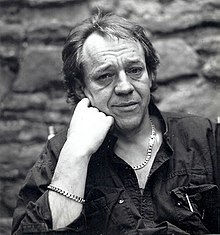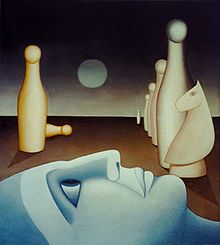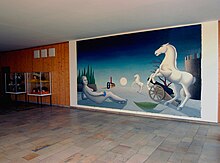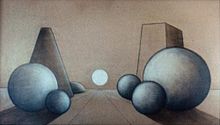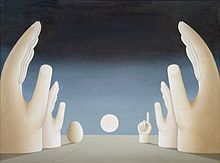Ladislaus Weiss
Ladislaus Weiss (born March 15, 1946 in Novi Sad , Socialist Federal Republic of Yugoslavia ; † July 4, 2020 in Santo Domingo , Dominican Republic ) was a German painter whose style is assigned to visionary realism . Its end-time landscapes, which are described as the eschatology of the end-times, are characteristic.
Life
Childhood and studies
Weiss was the third child of Alois Weiss (* 1905; † 1983) and Magdalene Weiss (* 1909; † 1993), who emigrated from Serbia to West Germany in 1958. From 1959 to 1962 he attended the St. Bernhard boarding school in Schwäbisch Gmünd and then completed an apprenticeship as a metal worker . At the same time he was a member of the Sindelfingen rock group “Les Masques”, which he left in 1966 to devote himself to painting and drawing as an autodidact . In 1967 he enrolled at the Free Art School in Stuttgart , and then studied for two semesters at the Merz Academy in Stuttgart. From 1969 to 1974 he studied painting and graphics at the State Academy of Fine Arts in Stuttgart .
Early years
Weiss moved into his first studio, a former police building on Schlossberg in Böblingen, in December 1970, where he lived until November 1972. The following works were created during this period: Path and Goal (oil 100 × 130 cm), Time and Eternity (oil 120 × 140 cm), Being and Becoming (oil 130 × 180 cm), Trojan Still Life (oil 134 × 160 cm) and moon harbor (oil 160 × 200 cm).
In 1973 he left Böblingen and in the same year moved to Ludwigsburg , where he moved into a studio apartment in 1973 in Leonberger Straße, a former royal riding barracks. He worked there until 1979. This is where the Occidental Vision cycle was created , as well as symbolic small studies that were taken up again in later works. In 1975 he got to know the Tübingen philosopher Hans Krämer , who later wrote the following about Weiss' work Occidental Vision : “In contrasting Schlemmer, but also Georgio De Chirico, something else becomes clear - and only then do we penetrate, mine I, on the peculiarities of Weiss's work: The perspective used meaningfully by Schlemmer is radicalized by Weiss into a cosmic spatial perspective and at the same time it gains a symbolic function for the dimension of time. And I think this is the decisive factor. What there is neither with Schlemmer nor with de Chirico, namely that the three-dimensionality of space symbolizes world time in its perspective direction; that turns the cosmic landscapes from white into eschatological landscapes into eschatological landscapes. "
In 1979, due to a general renovation ordered by the state, he had to give up the former riding barracks in Ludwigsburg and thus his studio there. He moved to Aichelberg in the Esslingen district for a year . During this time, the following small and medium-sized works were created: Europa I (white pencil heightened 22 × 28 cm, 1979), Europa II (pencil mixed medium 18 × 19 cm, 1979), Endwerk Europa (tempera 50 × 100 cm, 1979; owned by the Böblingen District Office) and Harpist's Dream (tempera 40 × 50 cm; owned by the Böblingen District Office).
He then lived in Freiburg im Breisgau for a year . There were mostly small-format drawings, as well as the dream of the harpist II .
In 1986 Weiss married the artist Rosita Bernadette Gonzales. Together, they were invited to that of Pope Pius XII founded Galleria La Pigna Roma, whose patron, the then Pope John Paul II. During the Marian Year on the theme: "Mary as Queen of Heaven and Earth," twenty artists from all over World, invited. Ladislaus Weiss was invited to represent the Federal Republic of Germany. In Weiss' mostly deserted, eschatological landscapes, the architectural fragments are oriented from a central perspective towards a center point, which is almost always represented by the sun. But since the sun is a traditional symbol for the Mother of God, his style of painting suits the theme. The exhibition in the Galleria La Pigna Roma gave Weiss' pictures an additional meaning. Following this, Ladislaus Weiss and Rosita Gonzales-Weiss received a gold medal from the Roman Instituto Beato Angelico. The certificate was signed by the President of the Tarsicio Piccari Institute. This medal was donated by Pope John Paul II, patron of the artists. Rosa and Ladislaus Weiss separated after two years of marriage and have been going their separate ways since 1988.
Foundation of the free art school for pictorial design
In 1982 Weiss returned from Freiburg im Breisgau to Böblingen. The city of Böblingen provided him with a studio in Tübinger Strasse, which he initially used as a studio. In parallel to his studio in Böblingen, he worked as a lecturer in art at the Herrenberg Adult Education Center . In the period from 1983 to 1986, in addition to his teaching activities, the monumental painting The End of the Industrial Age was created here . Shortly after the completion of the work, the vocational school "Stadtische Kunstschule Herrenberg" was created, the course management and co-founding of which can be traced back to Weiss and the director of the Herrenberg Adult Education Center, Helge Bathelt.
Weiss left the municipal art school in Herrenberg in 1987 and founded the art school "Free Art School for Visual Design" in the rooms of his studio in Böblingen in 1988. During this period, he created several medium-format works, as well as his largest and most important work to date, Psychology of a belated landscape (135 × 160 cm, oil on canvas, 1983, district office Böblingen collection). The Free Art School for Visual Design was run by him until 1999. Here, as well as in the children's art school integrated there, around 300 students and schoolchildren were looked after and trained. In addition to Weiss, five other lecturers worked at this facility. The content of the training included a. a basic course, portfolio preparation for academies and technical colleges, a main course in the field of “free painting and graphic design”. In November 1994 Weiss was awarded an honorary doctorate in collaboration with the Free Art School for Pictorial Design in Böblingen. Due to illness, Weiss handed over the management of the art school to one of his students in 1999 and completely withdrew from the school.
Late years
After his recovery, Weiss resumed his painting activity in 2005. He moved into the “Blaues Haus” gallery in Böblingen. It was here that his second largest work, Status Quo, and various related studies were created. His first exhibition after 2005 took place in May 2008 in the “Mo-Hotel” in Stuttgart- Vaihingen . Around 20 of his works were presented here in a solo exhibition. In addition to exhibitions in the Boeblingen district, u. a. in the district office and the Blaues Haus cultural center in Böblingen, Weiss was represented with some of his works at the International Biennale of Contemporary Art in Florence in 2009 .
In 2013 the work Unfinished History , created by Weiss in 1984, was published in the eschatology edition of the teaching material series "Religion affects us". Religion affects us, is a material service for religious instruction in schools for the Protestant and Catholic denominations. The publication appeared with a total circulation of 2,600 copies. Since May 2013 Weiss' “Unfinished History” has been part of ecumenical religious instruction.
Weiss lived in Santo Domingo (Dominican Republic) from 2017 , where he completed his work Antropologia Dominicana in 2018 . Since 2018 he has been a member of the professional association of the fine arts Colegio Dominicano de Artistas Plásticos (CODAP). He died in 2020 as a result of a Covid-19 infection.
Works
- Stil life, oil on canvas, 1971, 134 × 160 cm (head office, Kreissparkasse Böblingen)
- Mondhafen, oil on canvas, 1971, 134 × 160 cm (Herrenberg, property of the city of Herrenberg)
- Occidental Visions, oil on canvas, 1977, 180 × 200 cm (Böblingen, District Office)
- Europe, tempera, 1979, 50 × 100 cm (head office, Kreissparkasse Böblingen)
- Dream of the harp player, tempera, 1979, 40 × 50 cm (Böblingen district)
- The Apocalypse of Nostradamus, oil on canvas, 1982, 55 × 90 cm (head office, Kreissparkasse Böblingen)
- Level of Kings, mixmedium, 1982, 55 × 90 cm (City of Böblingen)
- Dream of the Harpist II, tempera, 1982, 40 × 50 cm (private collection)
- Psychology of a belated landscape, oil on canvas, 1983, 135 × 180 cm (Böblingen, District Office)
- The unfinished story, tempera, 1984, 50 × 100 cm (private collection)
- End times landscape, oil on canvas, 1984, 90 × 120 cm (District Office Böblingen)
- The end of the industrial age, 1983, 315 × 525 cm (District Office Böblingen)
- Status Quo, oil on canvas, 2005, 250 × 300 cm
- End times landscape, mixed media on paper, 1987, 80 × 120 cm (Collection of the Ministry of Art, Stuttgart)
- Return of the Caprids, 2007, 60 × 100 cm (private property)
- Beginning of the Golden Age, Acryl Mixed Medium, 2007, 75 × 115 cm
- Beginning of Creation, oil, 2007, 90 × 120 cm (private collection)
- Noah's Ark II, Oil Mixed Medium, 2008, 105 × 100 cm (District Office Böblingen)
- Beginning of the Third Millennium III, Oil Mixed Medium, 2008, 110 × 100 cm (private collection)
- Beginning of the third millennium, oil on canvas, 2009, 215 × 160 cm (private collection)
- Beginning of the Third Millennium II, oil on canvas, 2010, 215 × 160 cm (private collection)
- Wheat Landscape, Oil - Mixed Medium, 2012, 97 × 67 cm (private collection)
- Anatomy of the future, oil, 2012, 250 × 195 cm
- The world of the monotheists (reconciliation of religion), oil, 250 × 175 cm
- Antropologia Dominicana, oil, 2018, 250 x 170 cm
Exhibitions (selection)
- 1972 Böblingen Town Hall (solo exhibition)
- 1972 Böblinger Kunstverein, Böblingen Congress Hall
- 1973 Galerie Merklin Stuttgart (solo exhibition)
- 1976 Association of Visual Artists Baden-Württemberg, Stuttgart-Killesberg Exhibition Center
- 1976 TWS floor gallery Stuttgart (solo exhibition)
- 1978 Association of Visual Artists Baden-Württemberg, Self-Portraits 78, Gustav Sieglehaus Stuttgart
- 1983 District Art Exhibition Böblingen-Leonberg-Herrenberg
- 1983 100th exhibition of the Herrenberg Gallery (solo exhibition)
- 1983 50th anniversary exhibition of the Kreissparkasse Böblingen (solo exhibition)
- 1985 Contemporary art from Böblingen, Pontoise-France
- 1985 Contemporary art from Böblingen, Geleen- Netherlands
- 1985 Contemporary art from Böblingen, Krems, Austria
- 1985 Contemporary art from Böblingen, Alba, Italy
- 1986 Galerie la Pigna Roma
- 1994 District Office Böblingen
- 2008 Galerie Contact, Böblingen (solo exhibition)
- 2008 Mo-Hotel, Stuttgart-Vaihingen (solo exhibition)
- 2009 District Office Böblingen
- 2009 Florence Biennale of Contemporary Art, Italy
- 2015 Blaues Haus gallery, Böblingen
- 2018 Exhibición de LADISLAUS WEISS casa de la cultura dominico-alemana RD Santo Domingo 2018-nov-08
- 2019 Exhibicion de LADISLAUS WEISS museos de las casas reales Santo Domingo RD 2019
- 2019 Exhibicion de Ladislaus Weiss Centro Cultural Banreservas Santo Domingo November 11, 2019 (solo exhibition)
Individual evidence
- ^ Helge Joachim Bathelt : Ladislaus Weiss - Visionary Realism . Verlag Gebrüder Metz, Tübingen 1983, ISBN 3-921580-37-4 , p. 60 .
- ↑ Hans Krämer , Professor of Philosophy, Tübingen, 1977: Ethnological Security. 1977, archived from the original on February 14, 2016 ; accessed on June 15, 2016 .
- ^ General artist lexicon : Ladislaus Weiss . Ed .: international artist database.
- ↑ Photo credits to: Die Wanderzeit / Time of rambling 1958–1965 ( Memento from February 15, 2016 in the Internet Archive )
- ↑ Study certificates to be viewed at: Studienjahre / Time of study, 1967–1974 ( Memento from January 27, 2016 in the Internet Archive )
- ↑ Western Visions. In: Western Visions. Retrieved June 16, 2016 .
- ↑ Who´s Who in Visual Art. 100 Artists in Painting, Graphic Arts, Digital Arts, Sculpture . tape 2008-2009 , p. 97. Art Domain Whois Verlag, Hamburg, ISBN 978-3-00-024580-0 .
- ↑ Hans Krämer: Ladislaus Weiss. In: Forschungsinstitut Bildender Künste, GbdR (Ed.): ABBK. Address book visual artist . Edition 1990-1991. arte factum Verlag, Nuremberg 1986, ISBN 3-923326-65-3 .
- ↑ Ulrich Köppen: Ladislaus Weiss. Western vision . Wilhelm Schlecht Verlag, Böblingen 1977, ISBN 3-924513-25-2 .
- ↑ Literature on Ladislaus Weiss. Catalog of the German National Library, accessed on June 17, 2016 .
- ^ Galleria la Pigna. Retrieved June 21, 2016 .
- ↑ Heinz Hüer: Exhibited in Rome. Pictures by Ladislaus and Rosa Weiss . Ed .: Kreiszeitung. Boeblingen October 6, 1987.
- ^ Kreiszeitung (ed.): Gold medal for Böblingen artists . June 30, 1987.
- ^ Helge Joachim Bathelt: Art Overview about Ladislaus Weiss . Scharpf, Druck + Medien eK, Weil der Stadt 2016, ISBN 978-3-00-054575-7 .
- ↑ a b Freie Schule für bildhaftes Gestalten / Free school for pictographic composition Böblingen 1988–1999 ( Memento from November 5, 2016 in the Internet Archive )
- ↑ Chistian Fenske: Doctor Honoris Causa. Retrieved February 19, 2019 .
- ↑ The idea lives on. District newspaper Böblingen, March 23, 1988, archived from the original on January 30, 2016 ; Retrieved June 17, 2016 .
- ↑ Mingenbach, Hans-Michael; Ricken, Lothar: Approaches to the new eschatology: from the coming of God . Ed .: Religion concerns us 3/2013.
- ↑ The painter's comeback. Sindelfinger Zeitung, April 7, 2005, archived from the original on January 31, 2016 ; accessed on June 16, 2016 .
- ↑ Ladislaus Weiss exhibits in the Blue House. District newspaper Böblingen, September 22, 2015, accessed on June 22, 2016 .
- ↑ Biennalle Internazionale DellÁrte Contemporanea. Archived from the original on February 14, 2016 ; accessed on June 22, 2016 .
- ↑ Mingenbach, Hans-Michael; Ricken, Lothar: Approaches to the new eschatology: from the coming of God . In: Religion concerns us 3/2013 (ed.): Religion concerns us: current teaching materials; 3/2013 . Note no. ML8000499. Bergmoser + Höller Verlag AG, Achen.
- ↑ Exposición LADISLAUS WEISS. RD. Enero 2019. Accessed May 2, 2019 .
- ↑ CODAP Colegio Dominicano de Artistas Plásticos. Retrieved May 2, 2019 .
- ^ Eddie Langner: Böblingen painter Ladislaus Weiss died in the Caribbean. Böblinger Bote, July 7, 2020, accessed on July 14, 2020 .
- ↑ Solo exhibition in the Dominican Republic. Retrieved May 2, 2019 .
- ↑ Centro Cultural Banreserva: Centro Cultural Banreserva inaugura muestra cultural de Alemania. Retrieved May 2, 2019 .
| personal data | |
|---|---|
| SURNAME | Weiss, Ladislaus |
| BRIEF DESCRIPTION | Serbian-German painter |
| DATE OF BIRTH | March 15, 1946 |
| PLACE OF BIRTH | Novi Sad , Socialist Federal Republic of Yugoslavia |
| DATE OF DEATH | 4th July 2020 |
| Place of death | Santo Domingo , Dominican Republic |
